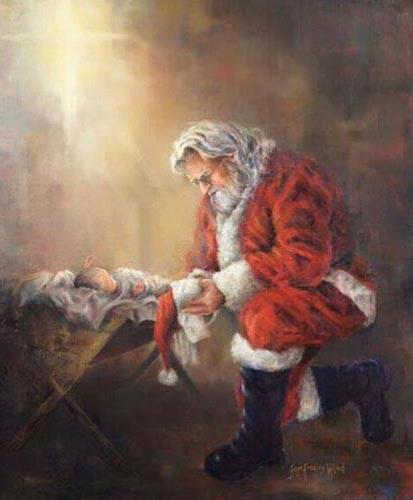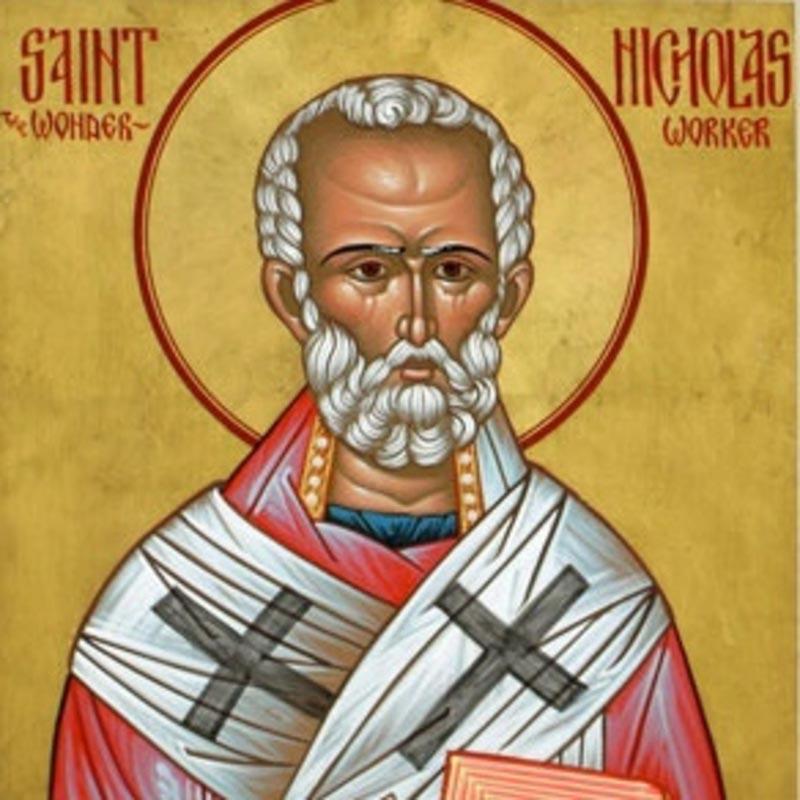Note: this is a piece I wrote for our church newsletter when I was pastoring waaaay back in 1994. At the time, my boys were 12, 9, 6, 3, and 2. I realize there is a difference in opinion on what to do with the secularization of Christmas and Santa Claus. But here is how we handled it with our kids (now all grown up).
As Christians, we are concerned with keeping the Christ in Christmas. As the holiday season comes upon us, our children are bombarded with images of the plump man in the red suit, elves, and presents presents presents! Santa Claus almost becomes like God, as the wise, all seeing (he sees you when you’re sleeping, he knows when you’re awake, he knows if you’ve been bad or good) one who bestows blessings.
What can we or should we do about it? Should we outlaw Christmas trees, gift giving, and ho ho ho because of its secularism and roots in pagan practices? Or should we foster the myth of Santa Claus?
Taking things to either extreme can cause problems. Back in 1994 my sister went to a church that had such strong feelings against the Christmas holiday that her family would not accept gifts, and would not even come to our family gatherings on Christmas – which was one of the few times that we all got together during the year. This went on for about 5 years. Christians are supposed to be separated from the worldly things, but this behavior did not present a good Christian witness to the rest of my family.
On the other hand, to teach the kids to believe in Santa Claus is a bad idea, too. When the kids get older and find out that you’ve been lying to them about Santa Clause (or the Easter Bunny), what’s to prevent them from suspecting your word about Jesus in the manger and the angels and shepherds?
In my family, we came up with a compromise that allowed our children to participate in the fun of the modern Christmas holiday, but properly emphasize the Christian aspects. How did we do that? We told them the truth about Santa Claus.
By this I don’t mean we told them that Santa Claus is a fake and a fairy tale – because that’s not the truth. Santa Claus has his roots in history, and in fact, in church history.
Nicholas was a man born in the Middle Eastern city of Myra in 271 A.D., and died on December 6, 343. He was from a wealthy family, but became an orphan. As a young man, he gave away his family’s fortune to the poor, at first attempting to do so anonymously by leaving sacks of money and food on people’s doorsteps (he was eventually found out). After the fortune was gone, he entered the priesthood. Eventually he became the archbishop of Myra, and ministering to the poor and orphans was always a central part of his ministry. It was said that he was a very fiery preacher!
Nicholas was canonized after his death, and became Saint Nicholas, the patron saint of children, sailors and merchants. He became popular throughout Europe, and many churches were built in his name. He became a favorite of the Dutch, who have long been seafarers and traders. In Dutch, Saint Nicholas is Sinterklaas, from which is rendered the modern day Santa Klaus. To add to the similarities to the modern day Santa, in his older days Nicholas had a long flowing white beard, and his bishop’s robes were red.
The Dutch would celebrate Sinterklaas Eve on Dec. 5, with a “parade” on the waterways of Amsterdaam headed by Sinterklaas in his bishop’s robes, and accompanied by his sidekick, Black Peter the Moor. The holiday is celebrated with gift giving, lots of good food, and clever little poems about the recipient receiving the gifts.
According to Dutch legend, at night Sinterklaas and Black Peter travel across Holland on a white steed, looking down chimneys to see if children have been good. He would leave small gifts and candy for the good children, and it was said that for the bad children, there was plenty of space in Black Peter’s bag to take them away!
It was the Dutch history and legend of Sinterklass that influenced that inspired Clement Clark Moore to write a poem A Visit from Saint Nicholas. It was first published anonymously in 1823, and Moore claimed authorship in 1837. It became known under the title, The Night Before Christmas. It was from this poem that we get the image of the jolly old elf from the north pole who rode in a sleigh pulled by eight reindeer, climbing down the chimney to leave presents in the dead of night. Moore only wrote it as a story to amuse his children – it was Satan who elevated the story to a legend, to become a substitute for Christ at Christmas.
The bottom line is that the real Santa Claus, Saint Nicholas, was a Christian. I remember seeing a statuette in a gift shop that expressed the sentiment perfectly. It had Santa in his red suit, cap in hand, kneeling before the manger and worshipping the Christ Child.

So in our family, we told our kids that the real Santa Claus was a Christian names Nicholas who lived hundreds of years ago, who gave gifts to children and the poor. No, he didn’t live at the North Pole or ride out in a sleigh pulled by flying reindeer to deliver gifts on Christmas Eve. They knew that a gift under the tree from “Santa” was actually me (ho ho ho!).
The Santa Claus at the mall was someone dressed up like him; but if you wanted to sit in his lap and tell him what you want for Christmas, go ahead and have fun.
We would have the tree, the lights, the gifts, the gathering of family, but we also taught them the real Reason for the Season was Jesus Christ.
The History Channel came out with a Biography on the origins of Santa Claus that was very good. I can only find a few clips from it and some other sources on YouTube.
The History Channel has a full Biography on the Origins of Santa Claus. I can find a few pieces of it on YouTube, and some other sources.




